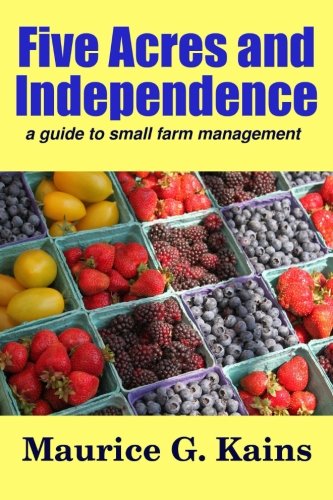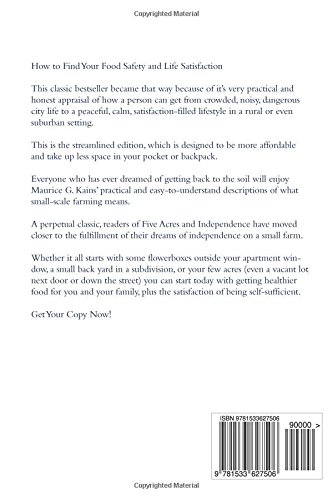


Full description not available
D**N
came in excellent shape
book came today. brand new book in excellent shape.
L**N
An honest take
There is a real reason why you find this on the reading list if so many successful farmers.While it is certainly a dated presentation, the value in the text lies in the unflinching honesty and comprehensive breadth required to actually farm. It is premiated by the test of time, in a sea of instant, untested books clamoring for significance.
D**L
For Small Fruit and Vegetable Farmers, the Past is the Future
This book was first published in 1935 and was last updated in 1940. The 1973 edition is the unabridged 1940 edition with a new introduction. As others have noted, it is very light on farm animals, as the author judged that five acres was too small for raising animals for a profit. (But try some chickens and bees and fatten one or two pigs if you wish.) It is almost encyclopedic on all things related to fruit and vegetable growing science and the other practices of the small farmer working long hours growing vegetables for a profit. This is for people who might enjoy manual labor and a rural life. This is not for the gentleman farmer with horses for the kids.Although thousands tried the formula of this best-seller in the depression years, it seems today at best an alternative life style (hobby farming) for those who have at least a modest other source of income. I grew up in rural, southeastern Minnesota in the 1950s. Among the prevalent 80 - 160 acre dairy farms, there was usually a handful of ten-acre or less small farms at the edge of town with a man (or less frequently a woman) in the family holding a day job in addition to the farming.You can implement this vision with five or so acres and some good hand tools, including a wheeled implement called a row hoe - used with a variety of bolt-on attachments for planting, cultivating, and weeding. Today these are mostly copies of designs from the early part of the 20th century and are readily available new for less than $450 - with a nearly full assortment of attachments. A small lawn tractor or a powered walk-behind cultivator would be useful; but are not mentioned and were not in common use when the book was written.The author was considered an expert in his day and his writing is very pleasant on a subject that few would find exciting. I am planning to retire and buy a six-acre property not far from the Delaware in far northwestern New Jersey. I will find what I need in this book as to soil care, crop selection, and layout.
K**K
Bought as gift
My boyfriend ordered this book - I cannot review it.
L**R
Everyone seems to be worried about "hard Times"....
If you are really are concerned about having to go into subsistence farming or gardening and how to plan your garden or small farm crops this book is for you. It does not tell you about home/farm defense, which weapons have the best accuracy or highest rate of fire you will have to look elsewhere. This book was written in the very early 1940s by a professor of Agriculture at Texas A&M University and has been in continuous print to this date. You can believe some what North of A&M in the Texas Panhandle Farming in the early post Dustbowl days was nigh impossible. This book was useful to our folks up here in that day. I am retired from the Army and have used this book in VA, NM, Germany and now TX. I have always found useful information for those four climates in this book. It is somewhat of a text book and may have been a companion text for a course at some point.
T**R
Excellent book on small farming--even though it is outdated.
This is a very detailed book on all of the areas that a small farmer needs to know about--granted some of hte information is outdated and at times the author offers opinion rather than scientific data, but the reader should know that Kains is a highly experienced farmer from many farms and soil types, so his opinion is more valuable than your average farmer.I recommend this book to anyone who is starting a small farm to help them grasp the basics--read this book first, then go into depth with other books.I also recommend it as a good refresher for old farmers--sometimes you forget tricks of the trade that you don't use often.
R**R
dated; can be laborious to read
It's OK. I was expecting a lot from this book. This is more than just a gardening book and can get highly technical. A friend of mine lauded it so highly, seemed like I was doing a disservice to my family trying to run a little hoop house garden (10x12) with a 10x12 open garden next to it under very trying conditions here in AZ without this as a reference.Information is dated, as the book was written in the 1930s. It provided an answer or two, but beyond that, the dated references and probably being too small an operator to make full use of it makes it of limited value to me. Because it was written "back in the day" the writing style made it a laborious read for me, at times.If you like a variety of references at your disposal, you might add it to your library. Otherwise there are more useful references even in online articles for the home gardener.
D**Y
Good details, poorly put together book
This book contains some valuable information, but it seems to be a collection of disparate chapters that do not hold together well as a whole. I will probably consult the tables in the appendices more than the information in the chapters. Of course, the book is dated-- I think I recall a recommendation to use arsenate of lead as a pesticide, which sounds nasty, and is probably illegal today.What probably grated on me more than anything else was the author's attitude -- he came very close to declaring that country people are the salt of the earth and anyone else is a poor excuse for a human being. I'm a country boy born and raised, and live in a rural village, but I've grown heartily tired of this self-righeousness. Rural America needs allies, and broadcasting this kind of attitude is no way to attract them.
E**O
Interesting book
Bought this nearly a year ago and found it very interesting from a historical view. The book was first published for the US market during the 1930s depression; pre petrochemical era. It was meant to help families survive very difficult times. It can be used now for reference and advice up to a point here in the UK but there are better books on the market.
M**R
Mould
No stars because the books smells so badly of mould I cannot read it ☹️Apparently I had to give at least one star !
J**H
old memories
This was read by my husband in the forties when it was first published. He always wished he had retained his original copy so we were delighted to find a coopy from Amazon.
M**S
Five Stars
As described - quick efficient service
A**E
Alt, aber dennoch sehr aktuell
Dieses Buch richtet sich nicht an Profi-Landwirte. Es ist lesenswert für Aussteiger, Selbstversorger die mit ihrem Land wirklich arbeiten (nicht nur idealistisch träumen) und vlt. auch etwas Gewinn erwirtschaften wollen. Englischgrundlagen vorausgesetzt, mit einem Wörterbuch oder translator geht es auch, gab der Autor 1935 (meine Auflage von 1973) Tipps zum sinnvollen Landkauf, Anlage von Gruben, Tierhaltung, Saatzucht und vielen anderen Punkten innerhalb der "Land-Wirtschaft" bei denen man Fehler machen kann, aber nicht sollte. Und obwohl es vor so langer Zeit geschrieben wurde, gelten viele Dinge heute noch und wir haben uns dabei ertappt, wie wir exakt die Fehler gemacht haben, zu denen der Autor Tipps gegeben hatte. Die Zeichnungen des Autors sind ein wenig gewöhnungsbedürftig, aber nach einer Weile auch schlüssig. Vorausgesetzt, man berücksichtigt die Ratschläge im Buch, kombiniert sie mit den heutigen Auflagen und Vorschriften, bilden diese gemeinsam ein sehr brauchbares Wissen für jemanden der Kleinlandwirtschaft zumindest mal kostenneutral betreiben möchte.
Trustpilot
1 day ago
2 days ago
4 days ago
1 week ago